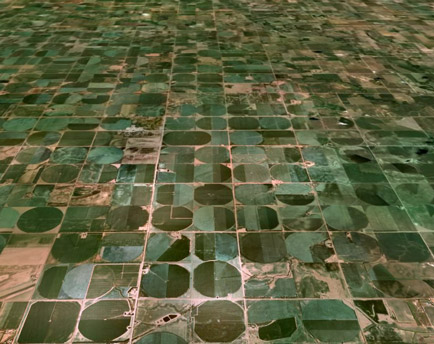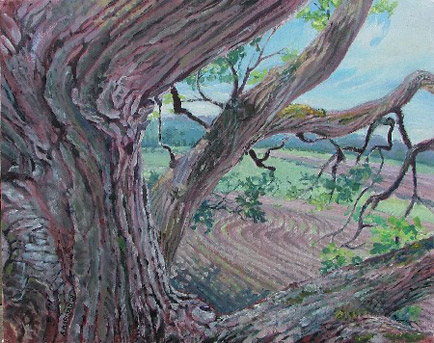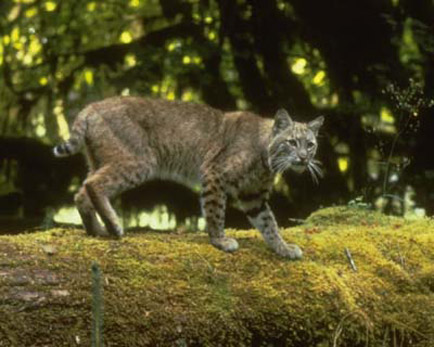November 10, 2009

A friend called and said, “If you can come with me, I will show you some interesting places not far from here” and I was delighted to see what might be new to the eye. We drove on gravel roads past fields that appeared mundane and ubiquitous in this part of the country, and turned into a field from which the beans had been harvested. There was not a great deal of color left, mostly grey and tan and dry soil. We stopped the vehicle near a small gathering of young cedar trees, and walking from there, just a bit uphill, found ourselves on the lip of a hollowed out part of the landscape, quite deep, and filled with bur oaks. Of all the species of oak, bur oak trees grow the most slowly, about a foot a year. This means that the branches are very angular and bent looking, like fingers with many joints reaching in every direction. These oak trees had to be beyond a hundred years old because they were very large and tall with stout trunks. We walked down the side of the hollow a short distance through gold and bronze leaves that were at least five to six inches deep, and we saw wild turkeys and deer on the far side. There was a stream of water running through the center, with cornfields barely visible off to the north. My friend commented that this land was considered not tillable, and therefore, no one bothered with it. It was wonderful.

We returned to the four-wheel drive and drove on a little track that ran along a fence line between a wetland “set-aside” area and a field of not-yet-harvested corn to another place that did not appear extraordinary at all. This time, we walked downward toward a large creek curving around a hillock covered with more of the old bur oaks and other deciduous trees. It looked fairly deep, and the riverbanks were in plateaus showing a history of water flowing there for a very long time. The hill on the other side obviously belonged to the wild creatures, and the area where we were had paths worn down with the hoof prints of many deer and other animals. As I stood there looking across the chasm at this place made beautiful with shadows and light in the early winter sun, I had to think of the huge wall tapestries we viewed in European museums that portrayed forest scenes of long ago. More than once, we have heard people speak of the dullness of the Nebraska scenery as viewed from car windows as they drove as fast as possible on the Interstate in order to move on to more dramatic places, but here, hidden away, secret and invisible across the plain fields of corn and beans lies an ancient and lovely moment in creation. The excursion made for an unforgettable day.

Last weekend, Alphie, who is healing from his knee operation, suddenly took off from the path on the southwest end of Sanctuary, running fast and with great abandon through the grasses and over branches, etc., treeing a forest creature. It had climbed to nearly the top of a cottonwood, was larger than a house cat, and was not a raccoon. I had my binoculars, so when I got nearer, I could look very carefully and study the animal from all angles, and there it was, an adolescent bobcat with beautiful face and ears, and the short tail that ended in a black stub. I looked up Nebraska bobcats upon returning, and verified my sighting. This was the first time I’d seen one in the wild in my entire life, so that was exciting. Alphie, however, tore out some stitches at the bottom of his incision, so this afternoon, we have to go to the vet and see what needs to be done. Until then, the whole thing was healing beautifully.
My health report remains very much the same. Somehow my body is able to move through episodes of “flu like symptoms” which take me to the clinic because I think sore lungs and coughs and such will carry me off, but after a number of days, I return to my form of “normal” which is not perfect, but is life and permits experiences such as those I described above. So I go on, with deep gratitude in my heart for a miracle that continues in spite of what is the expected outcome and I say each day, “Thanks be to God!”